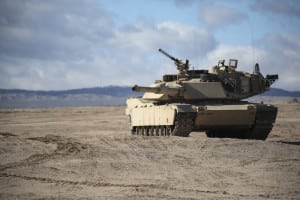The Army’s fiscal year 2023 budget request includes eliminating three programs and making reductions to another 32 efforts, officials told reporters Tuesday, as the service looked to secure full funding for its modernization portfolio.
A total of $12.6 billion in the Army’s budget request is specifically aligned to the service’s more than 30 signature modernization programs, according to Kirsten Taylor, director of investments at the Army’s budget office.

Maj. Gen. Mark Bennett, director of the Army budget, noted the three programs cut from the Army’s procurement and research and development accounts and transitioned over into sustainment resulted in $23 million in savings.
The programs eliminated were sniper rifle modifications for $4.3 million savings, modifications to PVS-14 night vision devices for $12.1 million and Medium Tactical Vehicle protection kits for $7.2 million, according to Bennett.
Brig. Gen. Mac McCurry, the Army G-8’s director of force development, cited reductions to the Abrams and Stryker programs as examples of the 32 efforts that had procurement rates slowed down in the budget request to generate savings.
“I would say, across the Army equipping portfolio, we balanced pretty significantly between continuing the momentum on modernization and targeted upgrades on our enduring equipment overall,” McCurry said. “We did some balancing between our modernization priorities and our enduring programs, while still looking out for the health of our industrial base.”
The Army told reporters it plans to provide a complete list of the 32 programs that received reductions in the budget request.
The Army’s $178 billion budget request for FY ‘23, rolled out on Monday, detailed funding levels for the Army’s slate of modernization initiatives, with the officials on Tuesday offering more specifics on how the service is likely to spend those funds for several of the programs (Defense Daily, March 28).
On the Optionally Manned Fighting Vehicle program, which received $590 million in the budget request, McCurry noted it would resource the move into the detailed design phase following the award of contracts to three vendors.
“Labor and material costs for design engineering, systems engineering program management, test and data development,” McCurry said. “It will also fund procurement of some long lead prototype materials to ensure we have test assets produced on time and delivered to the program schedule.”
The Army released the draft Request for Proposals for the next two phases of the OMFV competition in early March, which would cover detailed design and building and testing of prototypes for the Bradley replacement effort (Defense Daily, March 1).
For the $462.5 million in the budget request for the Microsoft [MSFT]-built Integrated Visual Augmentation System, the Army’s new augmented reality headset, $400 million would cover procurement of just over 7,000 headsets and $62 million would go toward research and development for 1.2 version of the system.
In the final FY ‘22 defense spending bill, lawmakers withheld $350 million of the total $405.1 million for IVAS procurement until the completion of initial operational test and evaluation (IOT&E) and after Army officials brief Congress on the status of the program (Defense Daily, March 25).
The Army is also seeking $1.5 billion across its R&D and Operations and Maintenance accounts for its Future Vertical Lift portfolio, split between $468.7 million for the Future Attack Reconnaissance Aircraft (FARA), $693.9 million for the Future Long Range Assault Aircraft (FLRAA) and over $300 million for the Future Tactical UAS program.
“With the RDT&E [for FARA], we continue hardware and software development of components, subsystem assembly, integration and test of hardware and software-in-the-loop efforts. We’re planning for the [government-furnished equipment] planning and [Modular Open Systems Architecture] development as we reach for competitive prototype aircraft and the competitive prototype flight demonstrations in the fourth quarter of [FY] ‘23,” McCurry said. “[With FLRAA], we’ll complete preliminary design efforts for weapons systems and virtual prototyping and looking for weapon system development contract options later in the year. And we’re doing preliminary analysis on requirements for how it also would support additional utility missions for MEDEVAC and Special Operations.”
For FARA, the Army has selected Bell’s [TXT] 360 Invictus and Sikorsky’s [LMT] Raider X designs for a competitive prototyping phase, with first test flights slated for 2023.
For FLRAA, Bell’s V-280 tiltrotor offering is competing against a Sikorsky-Boeing [BA] team’s Defiant X platform, with a production contract to be awarded in late fiscal year 2022.